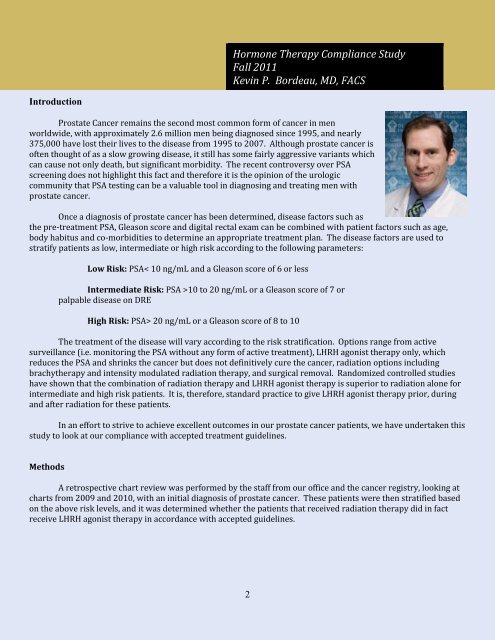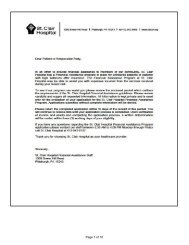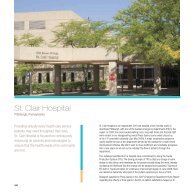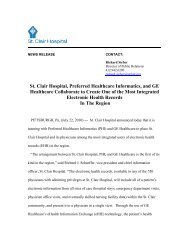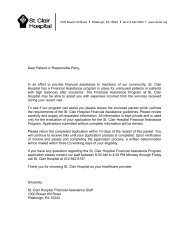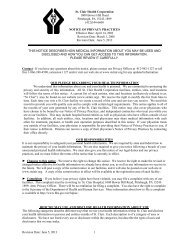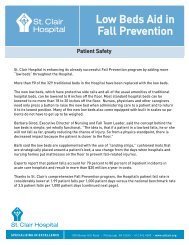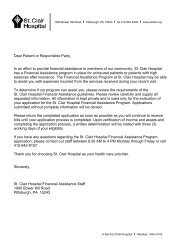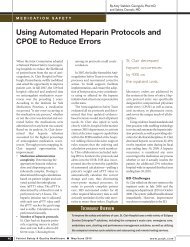Cancer Program Annual Report - St. Clair Hospital
Cancer Program Annual Report - St. Clair Hospital
Cancer Program Annual Report - St. Clair Hospital
Create successful ePaper yourself
Turn your PDF publications into a flip-book with our unique Google optimized e-Paper software.
Hormone Therapy Compliance <strong>St</strong>udy<br />
Fall 2011<br />
Kevin P. Bordeau, MD, FACS<br />
Introduction<br />
Prostate <strong>Cancer</strong> remains the second most common form of cancer in men<br />
worldwide, with approximately 2.6 million men being diagnosed since 1995, and nearly<br />
375,000 have lost their lives to the disease from 1995 to 2007. Although prostate cancer is<br />
often thought of as a slow growing disease, it still has some fairly aggressive variants which<br />
can cause not only death, but significant morbidity. The recent controversy over PSA<br />
screening does not highlight this fact and therefore it is the opinion of the urologic<br />
community that PSA testing can be a valuable tool in diagnosing and treating men with<br />
prostate cancer.<br />
Once a diagnosis of prostate cancer has been determined, disease factors such as<br />
the pre-treatment PSA, Gleason score and digital rectal exam can be combined with patient factors such as age,<br />
body habitus and co-morbidities to determine an appropriate treatment plan. The disease factors are used to<br />
stratify patients as low, intermediate or high risk according to the following parameters:<br />
Low Risk: PSA< 10 ng/mL and a Gleason score of 6 or less<br />
Intermediate Risk: PSA >10 to 20 ng/mL or a Gleason score of 7 or<br />
palpable disease on DRE<br />
High Risk: PSA> 20 ng/mL or a Gleason score of 8 to 10<br />
The treatment of the disease will vary according to the risk stratification. Options range from active<br />
surveillance (i.e. monitoring the PSA without any form of active treatment), LHRH agonist therapy only, which<br />
reduces the PSA and shrinks the cancer but does not definitively cure the cancer, radiation options including<br />
brachytherapy and intensity modulated radiation therapy, and surgical removal. Randomized controlled studies<br />
have shown that the combination of radiation therapy and LHRH agonist therapy is superior to radiation alone for<br />
intermediate and high risk patients. It is, therefore, standard practice to give LHRH agonist therapy prior, during<br />
and after radiation for these patients.<br />
In an effort to strive to achieve excellent outcomes in our prostate cancer patients, we have undertaken this<br />
study to look at our compliance with accepted treatment guidelines.<br />
Methods<br />
A retrospective chart review was performed by the staff from our office and the cancer registry, looking at<br />
charts from 2009 and 2010, with an initial diagnosis of prostate cancer. These patients were then stratified based<br />
on the above risk levels, and it was determined whether the patients that received radiation therapy did in fact<br />
receive LHRH agonist therapy in accordance with accepted guidelines.<br />
2


